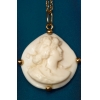|
 The word «cameo»
is frequently used in cases when it is required to depict something graceful, and
actually in these cases «cameo» from the noun turns into the descriptive
attribute. If a thing or phenomenon is described that they resemble cameo, it is
the same to state that the mentioned things are gracefully beautiful, and
unusually elegant. Stones with carved pictures made asrelief are called cameo. Thus, they differ from entails performed with deep
engraved pictures, and were used as seals during ancient times. The word «cameo»
is frequently used in cases when it is required to depict something graceful, and
actually in these cases «cameo» from the noun turns into the descriptive
attribute. If a thing or phenomenon is described that they resemble cameo, it is
the same to state that the mentioned things are gracefully beautiful, and
unusually elegant. Stones with carved pictures made asrelief are called cameo. Thus, they differ from entails performed with deep
engraved pictures, and were used as seals during ancient times.
«Cameo» is believed
to appear in XIII century from the French word camaheu, camaieul, that
corresponds to the Greek word κειμήλιον meaning jewelry, and was
delivered from the Byzantine East by the crusaders.
In IV century
B.C. the qualified stone cutters would carve scarabs, lions and sphinxes like
ancient charms assigned to keep off misfortune and diseases. Though real cameos
are embossed multicolored gems that are often made on sardonyx stones (kind of multilayered
agate), they appeared only in the end of IV - beginning of III centuries B.C.
Sardonyx is
always the perfect stone to make cameo when the relief is accentuated with the
various tint of layers, and the master use of such tints made it possible to
acquire real picturesque color effects. The illusion of light-to-dark modeling
was achieved with variations of the thickness of the white agate in the way to
see the darker lower layer.
Alexandria is believed to be the motherland of
cameo and this was the city where ancient legendary cameos were made, like cameos
with portrays of Ptolemaic II and Arsinoya, «Farneze cup», «Ptolemiac bowl» and
others. These cameos were made by the Greek craftsmen who were in the Alexandrian
court of Ptolemaic.
When various
minerals of all colors were delivered from the East, new cameos appeared as
well, that quickly became the items of luxury. They were used to trim rings and
tiaras, the clothes of kings and priests were decorated with these stones, the
luxury table ware was decorated, as well as culture items, furniture and
musical tools. And the most appreciated were the vessels from crystal, chalcedony
and onyx with relief pictures.
Cameo making
is not only handicraft, but in addition it is obstinacy, fantastic patience and
inspiration to the beauty and belief in wonder. One of the best experts of
glyptics (art of anaglyphy), the French researcher of the early XX century E. Bablon noted that for the big cameo, like the
Ptolemaic picture, it took the same period of time as for the construction of
the entire cathedral.
Cameos were
like decoration, yet the splendid art of stone cutters allowed reproducing the
pictures of ancient painters engraved in stones. Reproduction of pictures
engraved on stones is still kept till update, and today they are the only
source to get to know to the lost ancient art.
Catherine II
was rather keen on ancient gems, and in the letter to Grimm, the French enlightener,
she wrote: «My small collection of carved stones is such that yesterday four
people were hardly carrying two baskets with drawers where only half of
collection was there; and to avoid troubles, you'd better know that they were
baskets to carry firewood in winter». The Empress called her passion to
collecting gems «cameo disease». This «disease» brought to the fact that in the
end of reign of Catherine II over 10000 various cameos were kept in the Hermitage Museum. A year before she died, she was
so proud to say that, «All collections of Europe,
as compared with ours, are like fancy of kids». In what follows the collection grew
due to the obtaining of various collections by the Hermitage Museum,
as well as due to donation from individuals and members of the emperor family.
Recently cameos
are in vogue again, they are not only to remain antique fascination but quite
modern decoration. As soon as romantic trends are in vogue again, and designers
launched collections full of femininity, decorated with laces, bows and flowers,
and cameos immediately revived again. Now almost all designers of the world reputation
create collections of cameo as compliment to clothes. For example, the jeweler of
the Dior Joaillerie House, Victoire de Castellane, talks about the collection
in white-and-black gamut, created by him: «I created the collection of cameo on
the base of antique items. I would take ancient brooches and made rings from
them, decorating cameos with diamonds, pink sapphires, garnets and gold. As a
result, we have an astonishing contrast between the matt stone and brilliant
trimming».
Moreover, belts
and shawls are decorated with cameos, as well as velvet ribbon on the neck in
the ancient style. Cameo looks perfect in brooches, yet Sharon Stone prefers
rings and earrings with cameo for many occasions.
|